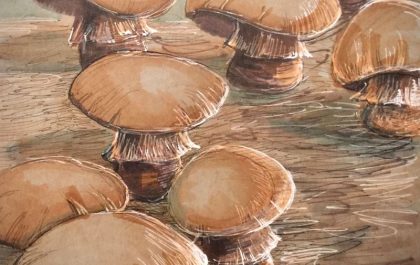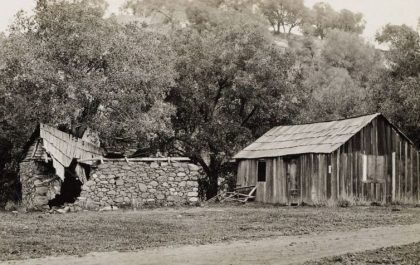Historians use documents and artifacts to determine human motivations and intentions. For instance, when Abigail Adams reminded her husband John that he should “remember the ladies” while creating a new nation dedicated to equality, understanding the meaning of her request means understanding what she had on her mind as she wrote it. Or, in another setting, when examining Anasazi ruins in America’s desert Southwest, we fuel our curiosity by wondering why this ancient civilization abandoned their cliff-side dwellings while our primary line of inquiry is to ask simply, “What were they thinking at the time?” and “Why did they behave as they did?”
Of course, we can never be certain of the motivations and intentions of long-dead people. All we can hope for is to accumulate enough source material to make thoughtful assumptions. This observation is not made to undermine the validity of the historical record but to emphasize that history is not so much a record of what has happened but, rather, what we make of that record as it exists in our day.
For me, this means that any exercise in reading or writing history should include a healthy bit of skepticism. First and foremost, the skeptical historian acknowledges that the record as we now see it was not necessarily created by those hoping to make sure we get the story right today. Indeed, many prominent actors throughout history have intentionally struggled to craft a narrative that suits human ego rather than human truth.
We can be pretty sure of the things that someone did or the things they said or wrote, but what about that which led them to it? Enter: historical fiction, which often attempts to answer this one and, if done well, can stoke the imagination. And, if done with a careful consideration of the actual record, can firm up the foundation of that record.

This is one of the reasons why The Adventures of Huckleberry Finn (1884-1885) stands as a hallmark of American storytelling. Set roughly 25 years before the American Civil War, the story is the first-person narrative of Huckleberry Finn, the 13 year-old son of a drunken and abusive father. Since Huck is telling the story, the written word here reads as Huckleberry thinks; filtered through an author who seems to grasp, perhaps better than anyone, the fickle nature of history.
Huck introduces himself in the first line: “You don’t know about me, without you have read a book by the name of ‘The Adventures of Tom Sawyer,’ but that ain’t no matter. That book was made by Mr. Mark Twain, and he told the truth, mainly.”
This is not the first time I have written about Huckleberry Finn. “My favorite Mark Twain story is about Huckleberry Finn and the slave Jim floating down the Mississippi River on a raft. Huck was running away from an abusive father who drank too much. Jim was running away from an abusive society that pretended all men are created equal.
“On shore, Huck and Jim had been assigned roles they didn’t want to play. The river was their escape. Huck’s big revelation on the water was that Jim missed his family, that he loved them. You see, society had tried to teach Huck that this was not possible, that slaves were not capable of such human things. Society can be funny this way even though the people in it avoid this kind of thinking.
“This is where Mark Twain made his mark, calling society to account for all of its nonsense; in this case by telling a story of a boy and a runaway slave adrift on a raft. Huck and Jim are part of the biggest runaway story ever, running away from the damage that slavery does to anyone who gets close to it. It was on the raft floating down the Mississippi that Huck learned that he and Jim were not that different. It was on the river, away from society, that they became friends.”*
Getting inside Huckleberry’s head allows us to ponder the idea that much of what we may think today is a product of the norms of the society within which we have been raised. Huck also teaches us that our experiences can lead us to challenge those norms. It is social commentary such as this that has made Adventures of Huckleberry Finn a classic of American literature and what many believe is the first truly American novel in an American voice.
But what about Jim? We are introduced to him and even get to know him a bit through his dialogue with Huck and a few others; but what the heck is going on inside his head?
This question is given a plausible answer in James (2024) by Percival Everett. As it turns out, Everett’s Jim has been sneaking into Judge Thatcher’s vast library and has developed quite an intellect reading the works of Voltaire, John Locke, John Stuart Mill, and other Enlightenment thinkers. So, throughout James, we hear from an enslaved, educated James… but also from the slave Jim whose situation demands putting on a show for white people.
In an early scene, James is teaching a group of six Black children how to get along with white folks. The children repeat what they have already learned:
“Don’t make eye contact.”
“Never speak first.”
“Never address any subject directly when talking to another slave.”
And, when speaking to whites, Jim tells them, “White folks expect us to sound a certain way and it can only help if we don’t disappoint them.”
A student chimes in, “And the better they feel, the safer we are.” Yes, that’s true, but how are you supposed to say it? “Da mo’ betta’ dey feels, da mo’ safer we be.” Very good.
Just as in Twain’s original, the many adventures and predicaments Huck and Jim find themselves in are juxtaposed with philosophical and ethical conversations taking place as they float down the Mississippi at night or in a hideaway spot during the day.
Huck’s dilemma: Huck has assured Jim that he can be trusted but Huck knows that Jim is the property of Miss Watson. Has Huck stolen Jim? On the raft, Huck asks, “How am I s’posed to know what good is?” Here is a boy who is quick to deceive and break the rules yet, he has a sound moral compass; and also a keen understanding that a lot of the “rules” are bad.
Still not ready to let on that he can speak and write with eloquence, Jim replies in response, “Way I see it is dis. If’n ya gots to hab a rule to tells ya’ what’s good, if’n ya gots to hab good ‘splained to ya, den ya cain’t be good. If’n ya need sum kinda God to tells ya right from wrong, den you won’t never know.”
Sublime thoughts such as this are explored more deeply as James dreams of conversations with the philosophers he has read about. Not only does James learn from these thinkers, he calls them to account for their oft-erroneous views on race.
Along the way, James acquires a pencil, which becomes a cherished possession obtained at no small cost in a world where slaves are denied the right to literacy. As he begins to put words to paper, we realize what has been denied to millions of enslaved people, their history. “With my pencil,” James says, “I wrote myself into being.”
Following one adventure, Huck realizes how gullible some white people are. The enlightened Jim/James tells him, “Folk be funny lak dat. Dey takes the lies dey want and throws away the truths dat scares ‘em.”
In a moment that drives to the heart of the original Huck Finn, Huck tells James, “I kin see how much you miss yer family… I forget you feel things jest like I feel. I know you love them.” James says, “Thank You, Huck.”
Some of the most powerful moments in Everett’s thoughtful novel occur after Huck and Jim meet up with a traveling minstrel show. When asked how they make money, a performer says blankly, “Yes, we put bootblack on our faces and pretend to be Negroes.”
As it turns out, James is light-skinned and he can sing. So… he joins the show as a Black man passing as white donning blackface pretending to be Black (Mark Twain lives!).
While performing, James realizes that something has changed because the people in the audience believe him to be white. “I made eye contact with a couple people in the crowd,” he says, “and the way they looked at me was different from any contact I had ever had with white people.” Staring at one white woman, he adds, “I saw the surface of her, merely the outer shell, and realized that she was mere surface all the way to her core.”
In the end, Huck comes to realize what Jim has always known. Society can beat you down and getting away from it can be therapeutic. Percival Everett reminds us that this is just as true now as it was true 140 years ago. While getting inside James’ head gets us away from his enslaved self, it is only the river that truly sets him free.
Mark Twain’s Huck Finn said it best: “We said there warn’t no home like a raft, after all. Other places do seem so cramped up and smothery, but a raft don’t. You feel mighty free and easy and comfortable on a raft.”
History in the News, Adrift, from Messenger Mountain News, September 21, 2018





